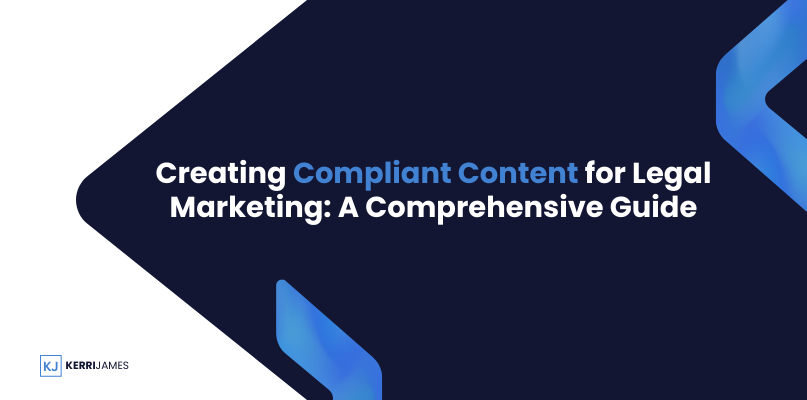In the competitive world of legal marketing, compliance isn’t just a buzzword—it’s a necessity. The legal industry is governed by strict rules and regulations, making the creation of marketing content a delicate balancing act. On one hand, you need to produce engaging and persuasive content that attracts potential clients; on the other, you must adhere to stringent compliance standards to avoid legal repercussions.
But what does it really mean to create compliant content for legal marketing? It’s about ensuring that every word, every claim, and every piece of content you produce is in line with the regulations set forth by governing bodies. It’s about transparency, accuracy, and ethical practice. This guide will delve deep into the essentials of compliance in legal marketing, offering best practices, strategies, and real-world examples to help you navigate this complex landscape.
Understanding Compliance in Legal Marketing
What is Compliance?
Compliance in legal marketing refers to the adherence to rules and regulations that govern how law firms can market their services. These rules are designed to protect consumers from misleading information and ensure that legal marketing is conducted in an ethical manner. Compliance isn’t just about avoiding fines or penalties; it’s about building trust with your audience and maintaining the integrity of your firm.
Key Regulatory Bodies and Laws
The landscape of legal marketing is regulated by various bodies, each with its own set of rules. In the United States, the American Bar Association (ABA) provides a model code of ethics that many states adopt with their own modifications. These regulations cover a wide range of issues, from advertising and solicitation to the use of testimonials and online content.
Additionally, the Federal Trade Commission (FTC) oversees advertising practices to prevent deceptive marketing. International law firms must also consider regulations such as the General Data Protection Regulation (GDPR) in Europe, which governs how personal data is collected, stored, and used.
Risks of Non-Compliance
Failing to comply with these regulations can result in severe consequences. These might include hefty fines, lawsuits, and reputational damage that can be difficult to recover from. Moreover, non-compliant content can lead to the loss of client trust, which is invaluable in the legal field. For instance, a misleading claim about a legal outcome can not only attract the ire of regulatory bodies but also result in client dissatisfaction and potential malpractice claims.
Best Practices for Creating Compliant Content
Creating compliant content requires a thorough understanding of the rules and a commitment to ethical marketing practices. Here are some best practices to ensure your content stays on the right side of the law:
Know Your Audience
Understanding your audience is the first step in creating compliant content. Legal content must be tailored to the specific needs of your target audience while remaining within the bounds of legal regulations. For example, when marketing to potential clients, your content should address their legal concerns and provide valuable insights without making unfounded promises or guarantees.
Transparency and Accuracy
In legal marketing, transparency and accuracy are paramount. All claims made in your content should be truthful and verifiable. Avoid making exaggerated statements about your firm’s success rates or the outcomes of past cases. Instead, focus on providing honest information that potential clients can rely on.
For instance, if your firm has won a significant percentage of cases, provide the exact figures and context. Rather than saying, “We win most of our cases,” you might say, “Over the past five years, our firm has successfully resolved 85% of the cases we’ve handled, helping clients achieve favorable outcomes.”
Avoiding Misleading Information
Misleading information can be subtle, but it’s one of the most common pitfalls in legal marketing. This includes overpromising results, suggesting a particular outcome is guaranteed, or using ambiguous language that can be interpreted in multiple ways. To avoid this, ensure that your content is clear, concise, and free from any language that could be construed as misleading.
For example, instead of saying, “We guarantee you will win your case,” which is both misleading and non-compliant, opt for language like, “We will work diligently to provide you with the best possible representation based on our experience and knowledge.”
Disclaimers and Disclosures
Disclaimers and disclosures are essential tools in legal marketing. They provide the necessary context for your content and help manage client expectations. For example, if your content includes case studies or testimonials, include a disclaimer that clarifies that past results do not guarantee future outcomes. This not only protects your firm from potential claims of misleading advertising but also aligns with ethical standards.
A well-placed disclaimer could be something like: “The outcomes of the cases discussed are not indicative of the results you may achieve. Every case is unique and must be evaluated on its own facts and circumstances.”
Respecting Privacy and Data Protection
With the increasing importance of data protection, especially in the wake of regulations like GDPR, respecting privacy in your marketing content is crucial. Ensure that any personal data you collect through your website, newsletters, or contact forms is handled in accordance with these regulations. This includes obtaining explicit consent from users before collecting their data and providing them with clear information about how their data will be used.
Moreover, your content should never disclose confidential client information. Even anonymized case studies must be carefully vetted to ensure they do not inadvertently reveal sensitive details.
Content Strategies for Compliance
Compliance doesn’t mean your content has to be dry or unengaging. With the right strategies, you can create content that is both compliant and compelling.
Keyword Strategy and Compliance
Search Engine Optimization (SEO) is a critical component of any marketing strategy, but it must be approached carefully in the legal field. While keywords are important for ranking, they should never compromise compliance. Avoid using misleading keywords that could suggest guaranteed outcomes or misrepresent the nature of your services.
For example, instead of targeting a keyword like “guaranteed legal win,” which could lead to compliance issues, focus on more accurate terms like “experienced legal representation” or “skilled personal injury attorney.”
Balancing Legal Jargon and Accessibility
Legal content often involves complex jargon that can be difficult for the average person to understand. While it’s important to use accurate legal terms, you must also ensure your content is accessible to non-lawyers. Striking a balance between professional terminology and plain language can help you connect with a broader audience while remaining compliant.
A good approach is to define legal terms as they are introduced. For instance, if discussing “fiduciary duty,” explain it as “the legal obligation to act in another party’s best interest.” This not only makes the content more understandable but also demonstrates your firm’s commitment to clear communication.
Leveraging Legal Testimonials
Client testimonials are powerful tools in legal marketing, but they must be used carefully to avoid compliance issues. Ensure that any testimonials you use are truthful, represent the client’s actual experience, and are not exaggerated. Additionally, include disclaimers to clarify that these testimonials do not guarantee similar outcomes for other clients.
For example, a compliant testimonial might read: “Thanks to [Law Firm], I was able to settle my case in a manner that was satisfactory to me. However, every case is different, and outcomes can vary.”
Content Approval Processes
One of the best ways to ensure compliance is to implement a thorough content approval process. This involves multiple layers of review, including legal oversight, to catch any potential compliance issues before content is published. Regular training for your marketing team on the latest compliance standards can also help prevent mistakes.
A typical content approval process might include the following steps:
- Initial Draft: Written by the content team with compliance in mind.
- Internal Review: Reviewed by senior marketing staff to ensure the content aligns with brand guidelines and compliance standards.
- Legal Review: Evaluated by legal professionals to ensure all regulatory requirements are met.
- Final Approval: Final checks and publication.
Tools and Resources for Compliance
To maintain compliance consistently, leveraging the right tools and resources is essential.
Content Management Systems with Compliance Features
Modern content management systems (CMS) offer features that can help ensure compliance. For example, some CMS platforms allow you to set permissions and approval workflows, ensuring that all content is reviewed before it goes live. These systems can also track changes, making it easier to audit your content for compliance over time.
Examples of such tools include HubSpot’s CMS, which offers built-in compliance checks, and WordPress plugins like “GDPR Cookie Consent” that help manage data protection compliance.
Legal Compliance Checklists
Using checklists can be an effective way to ensure that your content meets all compliance standards. These checklists should cover all aspects of compliance, from the accuracy of legal claims to the proper use of client testimonials.
A basic compliance checklist might include:
- Verification of all legal claims and statistics.
- Inclusion of necessary disclaimers and disclosures.
- Review of data protection and privacy statements.
- Confirmation of non-misleading language.
- Approval from legal counsel.
Training and Continuous Education
Compliance is not a one-time task; it requires ongoing education and training. Regularly updating your marketing and legal teams on the latest regulations and best practices is crucial for maintaining compliance. Consider investing in compliance training programs that focus on the specific needs of legal marketing.
Additionally, staying informed about changes in legal marketing regulations through industry blogs, webinars, and conferences can help you stay ahead of potential compliance issues.
Case Studies: Compliant Content in Action
*note the names of the firms are annoymized
Learning from others’ experiences can provide valuable insights into how to create compliant content effectively.
Successful Examples
One notable example is a law firm that successfully used content marketing while staying fully compliant. This firm focused on providing educational content about legal processes, which helped them build trust with their audience. They avoided making direct claims about outcomes and instead emphasized their commitment to thorough, personalized representation.
Another example is a firm that implemented a robust content approval process, which included legal review at every stage. This proactive approach not only helped them avoid compliance issues but also positioned them as a trustworthy and reliable legal resource.
Lessons Learned from Non-Compliant Content
On the flip side, there are lessons to be learned from firms that failed to comply. For instance, a law firm that was fined for using misleading language in their advertisements serves as a cautionary tale. They made bold claims about their success rates without providing the necessary context, leading to accusations of false advertising.
Another example involved a firm that failed to include proper disclaimers in their online testimonials. This oversight resulted in a regulatory investigation and significant reputational damage. These cases highlight the importance of vigilance and thoroughness in every aspect of content creation.
Final thoughts
Creating compliant content for legal marketing is both a challenge and an opportunity. By adhering to best practices, understanding the regulations that govern legal marketing, and implementing thorough content approval processes, you can produce content that not only engages and informs your audience but also upholds the highest standards of ethics and compliance.
In this ever-evolving landscape, staying informed and proactive is key. Review your current content strategies, implement the tips provided in this guide, and ensure that your marketing efforts are always aligned with compliance standards.










